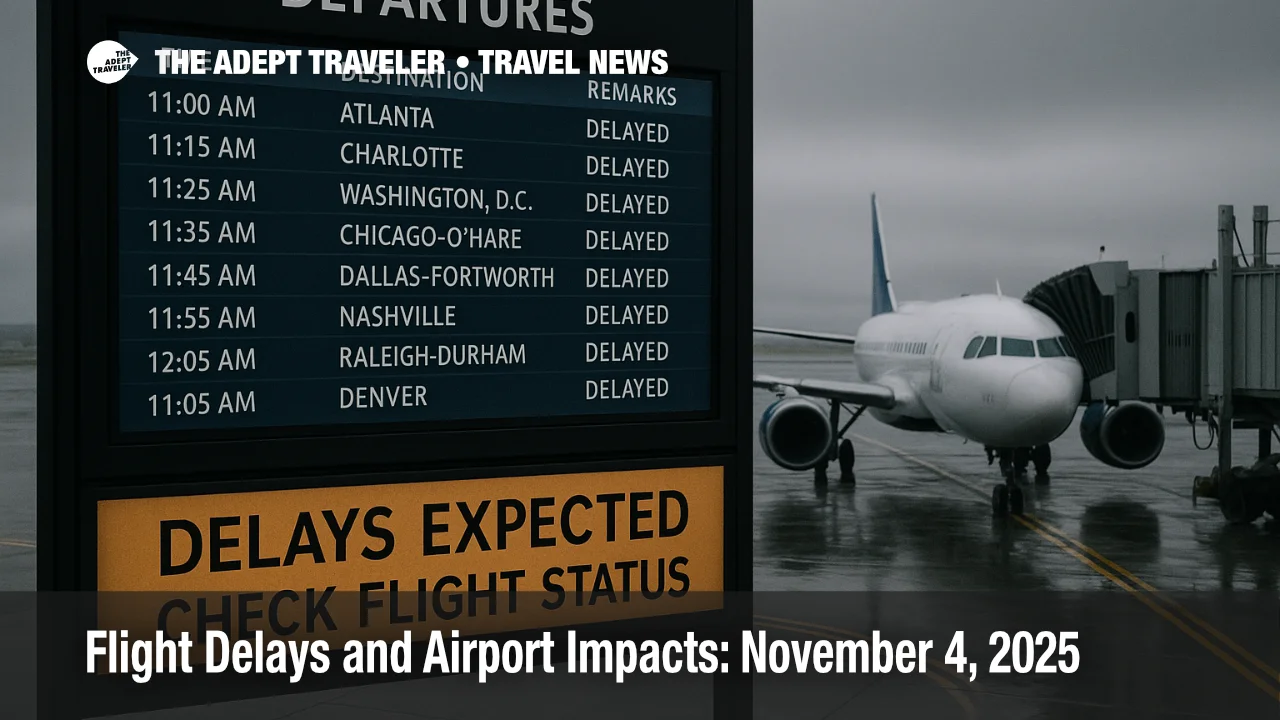Flight Delays and Airport Impacts: November 4, 2025

Key points
- ATCSCC flags strong winds at Boston Logan with a probable ground stop or delay program after 8:00 a.m. CT
- New York area airports LaGuardia and Newark have possible ground stops or delay programs after 8:00 a.m. CT
- San Francisco could see a ground stop or delay program after 10:00 a.m. CT with low ceilings at Seattle and San Diego
- A staffing trigger is active in the Philadelphia area through 10:00 a.m. CT but no EWR or TEB program yet
- Runway and taxiway works continue at multiple hubs including Houston Intercontinental, Orlando, and San Francisco
Impact
- Pad Connections
- Allow extra time for morning Northeast arrivals and late-morning West Coast connections
- Rebook Early
- If you have tight layovers through Boston, New York, or San Francisco, request earlier flights
- Monitor Programs
- Watch for ground stops or delay programs to post after 8:00 a.m. CT in BOS, LGA, EWR and after 10:00 a.m. CT at SFO
- Gate Changes Likely
- Construction and runway closures at select hubs may shift gates and taxi times
- Use Alerts
- Enable airline and airport push alerts for same-day operating changes
The Federal Aviation Administration's Air Traffic Control System Command Center expects the day's first pinch points in the Northeast and along the West Coast. Strong west winds at Boston Logan International Airport (BOS) may require a ground stop or a formal delay program after 800 a.m. CT, while New York LaGuardia Airport (LGA) and Newark Liberty International Airport (EWR) carry "possible" program risk in the same window. Out West, San Francisco International Airport (SFO) is "possible" for a program after 1000 a.m. CT, and low ceilings may slow Seattle-Tacoma International Airport (SEA) and San Diego International Airport (SAN). Travelers with morning arrivals into Boston and New York, or late-morning connections through San Francisco, should pad connections and consider earlier flights if available.
Latest developments
In the 757 a.m. CT operations plan update, the Command Center notes BOS running a runway 33 configuration with a reduced arrival rate due to strong winds and gusts. A shift to runway 32 later could lift rates, but arrival demand may still force a ground stop or a delay program. The same plan lists LGA and EWR as "possible" program candidates after 800 a.m. CT, and SFO as "possible" after 1000 a.m. CT. SEA and SAN are flagged for low ceilings. A staffing trigger is active for the Philadelphia area until 1000 a.m. CT, although no EWR or Teterboro initiative is required at this time.
Regional picture
Northeast operations will hinge on wind management and arrival spacing this morning. Expect vectoring and speed control on arrivals into Boston, plus conga-line taxi flows if programs post. For New York, any LaGuardia or Newark initiative typically ripples into the Washington-Boston corridor, so flyers connecting via Philadelphia International Airport (PHL) or John F. Kennedy International Airport (JFK) should build margin. On the West Coast, a stubborn marine layer can create extended arrival spacing at San Francisco with knock-on gate holds at up-line origins, and similar low-ceiling effects may slow first-bank flows at Seattle and San Diego. FAA's national planning page also highlights area thunderstorms for select en-route centers and a partial Lake Erie routing constraint tied to reduced Nav Canada capacity, which can add minutes in the Great Lakes lanes.
Infrastructure and construction notes
Runway and taxiway work remains a background factor at several large hubs. Today's FAA planning notes list, among others, runway closures or construction affecting George Bush Intercontinental Airport (IAH), Orlando International Airport (MCO), San Francisco International Airport (SFO), Charlotte Douglas International Airport (CLT), and Chicago O'Hare International Airport (ORD), along with specific navigation or ILS outages at Portland International Airport (PDX) and taxiway projects at Denver and San Francisco. These constraints can lengthen taxi-out times, shift gate assignments, or reduce arrival rates during peak periods.
Background, how FAA programs work
When conditions or staffing reduce an airport's acceptance rate, the FAA may issue a ground stop to meter inbound demand until conditions improve or a ground delay program (GDP) that assigns controlled arrival slots to spread traffic over time. These tools, published via the Air Traffic Control System Command Center, help maintain safe spacing and predictable flows during weather, wind, low ceilings, or staffing shortfalls. Travelers will see these show up as "ATC delay" or "air traffic control program" in airline apps. Always check the FAA's planning pages for situational awareness, then confirm specifics with your carrier for rebooking options.
What to do if you are booked today
If you are connecting through Boston, New York, or San Francisco, move to an earlier flight where feasible, especially if your layover is under 70-90 minutes. Enable push alerts in your airline app and watch for gate holds if a GDP posts, since your departure could be retimed to meet an assigned arrival slot at the destination. For West Coast morning banks into SFO, expect airborne spacing and potential ground waits at origins while the marine layer lifts. Construction at hubs like SFO, MCO, and IAH can also drive last-minute gate changes, so verify your gate on approach and follow airline directions to avoid missed connections. For system-wide context, remember that controller staffing remains tight during the ongoing federal shutdown, which can amplify routine weather and wind impacts; plan conservatively and keep your bookings flexible where possible.
